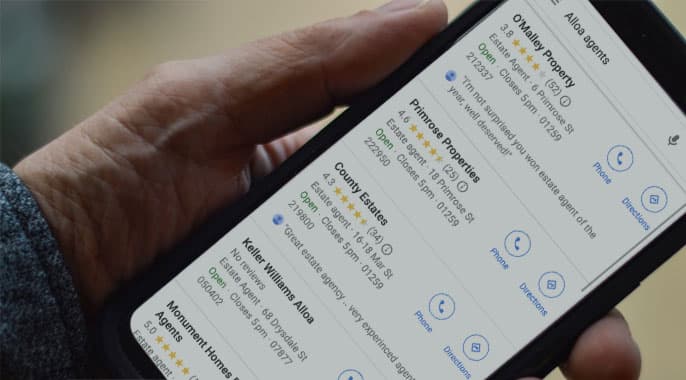In this article we’re doing our best to clarify the complex process of selling your house by breaking it down into smaller, manageable steps, and providing real examples of what our experts in Stirling and Alloa can do to help with each of these steps.
Find An Estate Agent
We’ve previously written an entire blog post on the topic of finding the right estate agent, and the advice we offer can be boiled down to a few simple principles. The first of these is that you need to do your research and look for an estate agent with a clear track record of successful transactions, preferably transactions involving houses which are similar to yours. An estate agent with a history of selling properties like yours will also be likely to have their own lists of potential buyers they expect to be interested in exactly that type of property. In addition, you need an estate agent with the marketing skills needed to put your house on the market in front of as many of the right kind of prospective buyers as possible, and a proactive approach meaning initial enquiries will be followed up with speed and enthusiasm in order to maximise the potential of any interest being shown. Finally, you want an estate agent with encyclopaedic local knowledge, able to call on details such as local transport links, schools and planned development in order to decide exactly how much your house should be able to fetch.
Initial Consultation
Once you’ve taken a look at the local estate agents have to offer – including reviews written by previous customers – you should meet with them in person. We have offices in both Stirling and Alloa where you can get to know our friendly teams. At this stage in the process the meeting with an estate agent will have two aims. The first is for you to get a ‘feel’ for the estate agent and whether they strike you as the kind of people who could successfully market your house. The word ‘feel’ is important here, because choosing an estate agent to work with, through what can sometimes be a complex and stressful process, is about gut feeling as much as anything else. You want to get the sense that an estate agent understands your requirements and will be there to offer support when you need it.

The other key aim of this initial meeting is for you to explain exactly what you’re looking for in terms of the sale, and for the estate agent to tell you how they can make it happen. This might include specific requirements for the sale, such as a strict timeline, the kind of price you’re hoping to achieve and even your reasons for the sale. If you need to move into another house in order to take up a new job, for example, this might mean you’re willing to drop the price a little in order to achieve a quicker sale. The estate agent should listen carefully, take all of the information you share on board and clearly explain how this will impact on the sales process.
Property Valuation
In many ways this is the most important part of the process, as it sets the benchmark for how much you can expect to receive for your house. A good piece of advice at this point is to arrange three different valuations, as the figures given can sometimes vary, and taking an average should mean you’re asking for a realistic amount. If you have your valuation done by one of the experts at O’Malley Property then we’ll make sure you know exactly what the valuation involves by sending you a video prior to any visit, talking you through the process and also making it easy for you to recognise the person when they knock on your door. It’s worth asking any estate agent if they do something similar, so that you feel comfortable letting them into your home, especially if you live alone.

The valuation process itself will involve an inspection of your property that takes around 30 minutes. Factors which will impact on the valuation an estate agent arrives at include the fundamentals of the house itself, such as the number of rooms (including bedrooms and bathrooms) its size in terms of floor space and the condition and state of repair the property is in. The details of the property itself will then be combined with local factors, such as whether it is close to highly rated schools, important transport links and local amenities such as doctors and dentists etc. Finally, valuers will use their knowledge of recent sales of similar properties and an understanding of trends in the housing market in Stirling and Alloa,– as well as wider trends across the central belt and in Scotland as a whole – to arrive at an estimated valuation. As well as the valuation, your estate agent should offer advice on anything you could do to increase the value of your property, ranging from repairs and redecoration to how to stage the rooms and how to create so-called ‘kerb appeal’. Even with a house in relatively good condition, there are things which you can do following an estimated valuation to make sure that it is as well-prepared for being put on the market as possible.
Getting Your House Ready
You might have given the interior and exterior of your house something of a face-lift before the visit from an estate agent, but you should definitely do so before people start paying you a visit to decide if they want to put in an offer.

The process will begin with you taking a step back and trying to see your house through the eyes of someone who has never seen it before, and is looking for somewhere to buy. If your house has a garden, then this process needs to be applied to the garden as well as to the house, and in all cases the exterior of the house, if it hasn’t been made to look its very best, could be a deal-breaker even before prospective buyers knock on your front door. Getting your house ready for viewings could involve any or all of the following steps:
- Paving – clean any outdoor paving, such as a garden path or patio, using a pressure washer if possible or a bucket of warm water, a scrubbing brush and a specialist detergent if not. It doesn’t sound like a lot of fun, but trust us, it will be worth it.
- Snag list – you may have heard of a snag list. It’s the list a builder draws up at the end of a project and it consists of all those little things – like a cracked plug socket, loose curtain rail or protruding nail – that remain to be sorted out. You need to look around your house, inside and out, and draw up a similar list, which will probably consist of all of those jobs you’ve been putting off for the last few months. Things like cracked fence panels and crooked gates outside the house, or leaking taps, missing light bulbs and loose cupboard doors inside are the kind of things you might have stopped even noticing over time, but you can be certain that any prospective buyers will spot them. Make a list and tick the repairs off as you get them sorted.
- In the garden – if your house has a garden then you should make sure that any lawn and flower beds are looking their best, with weeds and dead-looking plants dealt with. If you’re not the green fingered type you might even opt to get a professional in to give your garden a make-over. Clear away bulkier garden items such as lawnmowers, barbecues and garden furniture to create the archetypal blank canvas onto which prospective buyers will be able to project their own life and family.
- Front door – the front door of your house, in fact any doors and windows, are going to be amongst the first things that a prospective buyer gets a close look at. That’s why you should clean up PVC windows with specialist detergent and give any wooden door and window frames a fresh coat of paint. Are your door knocker and the hinges clean and polished? Does your doorbell work? Make sure the answers to questions like these are a clear ‘yes’, since any issues will generate an air of neglect which a prospective buyer is unlikely to find encouraging.
- Interior – once you’ve decided to put your house on the market you should think about renting a temporary self-storage unit. In that unit you should put as much of your furniture as you can live without while selling the house, in order to conjure up a sense of de-cluttered space, create the aforementioned blank canvas and allow prospective buyers to picture exactly what they could do with the space. Storage spaces such as garages, lofts or basements could also be cleared, enabling them to be flagged up as extra room, and the contents of your cupboards and wardrobes need to be tidied because, guess what? People viewing your house tend to be pretty nosy (and who can blame them?).
- Deep clean – once you’ve dealt with repairs and cleared as much space as possible you need to give the interior of your house a deep clean, starting with the walls, floors and ceilings and working through everything such as the interiors of your kitchen appliances and the grouting on your bathroom tiles.
- Arrange the furniture – the way in which your furniture is arranged has probably happened organically over the years. What you have to do now is make sure that the sofas, chairs and tables are set out in a manner which offers easy pathways in and out of each room and eliminates bottlenecks between the larger items.
- Lighting – put clear lighting in each room to avoid the impression that you’ve got anything to hide. Since the best light is natural light you need to make sure that curtains and blinds are open to flood the rooms with light and if the time of a visit makes this impossible, ensure that unobtrusive lighting such as lamps throws light into every corner of a room.
- Keep it up – you’re probably exhausted just reading about all of this cleaning and maintenance, but once you’ve done it you’ll need to work to maintain the standards you’ve set until the sale goes through. That means cleaning, dusting and polishing regularly and being highly vigilant when it comes to clutter working its way back into the rooms.
- Décor – you may well be rightfully proud of your unusual taste in décor and vivid choice of colour schemes, but you can trust us when we say that prospective buyers don’t want to see quirky. They want to look around a house that feels neutral, relaxed and ready for them to shape to their own tastes, so you need to apply a few coats of a colour scheme which ticks those boxes before viewing begins.
Pricing Strategy
Once the estate agent has valued your property, and you’ve taken any of the steps recommended to maximise that value, you need to agree an asking price. When you work with O’Malley Property we’ll explain, clearly and calmly, that the asking price will need to reflect not only the valuation but also other factors such as local market conditions and your individual requirements. If you’re looking for a quick sale, for example, we might suggest a slightly lower asking price, while an over-heating local market – perhaps because a new transport hub has opened or a local school has received an outstanding Ofsted rating – could mean you can ask for a little bit more.
Listing Agreement
Once you’ve decided that you want to work with an estate agent you’ll sign a listing agreement. This is a formal document setting out the fact that an estate agent is legally entitled to represent you and market your property, and the terms of this agreement. Once you’ve signed a listing agreement of this kind, your estate agent can set about marketing the property.
Marketing
When you work with O’Malley Property you enter into a genuine partnership, and we’ll liaise with you when it comes to the details of our marketing plan. This will include the professional photographs we’ll use to market the property, as well as details such as creating virtual tours of your property, placing the property on the right online listings and targeting advertising at carefully chosen prospective buyers. This is where the local expertise of an estate agent comes to the fore, as they will be armed with a list of potential buyers for whom your property could be ideal. The marketing plan will also consist of in-person showcases which might take the form of open-house viewings, private showings and virtual tours. In most cases a mixture of these methods will be applicable, and experts will be on hand with answers to any questions prospective buyers might have about your property and/or the wider locality of Stirling and Alloa.

Negotiating Offers
‘Buyer’ is the magic word in this whole process, of course, and your estate agent will pass on any offers they receive for your property from prospective buyers. They will also be able to offer advice on the details of each offer, such as whether they feel you’re likely to be offered more or whether the prospective buyer is in a position to complete the sale quickly or, alternatively, whether they are part of a chain. Another aspect to consider would be whether the prospective buyer is a cash or mortgage buyer and, if they need a mortgage to make the purchase, do they have a decision in principle to lend the money in place?
Managing The Transaction Process
Once you’ve decided to accept an offer there is still a lot of admin and paperwork to get through. The good news if you opt to work with O’Malley Property is that we’ll handle all of that paperwork on your behalf. This includes dealing with contracts and liaising with professionals such as conveyancers and solicitors to make sure that the sale is handled and processed as smoothly as possible. This might also involve the facilitation of inspections and appraisals required by any prospective buyers and their lenders. Throughout this process you’ll want your estate agent to keep the lines of communication open to make sure that you know exactly what is happening with your sale. To help, we have a dedicated team of experts on hand to deal with your calls and answer your questions from 9 am to 9 pm 7 days a week.

Closing The Sale
Once all of the relevant paperwork has been dealt with, your estate agent will work to complete the sale. This means ticking all of the boxes across all of the paperwork and ensuring that, on the day of completion, the relevant funds are transferred. In the first instance these funds will generally be transferred from the buyer or their mortgage provider to their legal representative, after which they will be transferred to your legal representative. At this point your legal representative will pay off debts such as any outstanding amount on your mortgage, the fees being charged by your estate agent and any service charges applicable as well as their own fees. When this has been done, the remaining money will be transferred to you.
Post-sale
The good news if you work with O’Malley Property is that our help and support doesn’t end when the sale goes through. We’ll still be available to help with post-sale issues such as recommending moving services and putting you in touch with experts such as builders that you may need to call on for your next property. Moving forward, we’ll always be here to offer advice and support, and when the time comes to sell your next property we hope you know exactly whose number you need to call.



